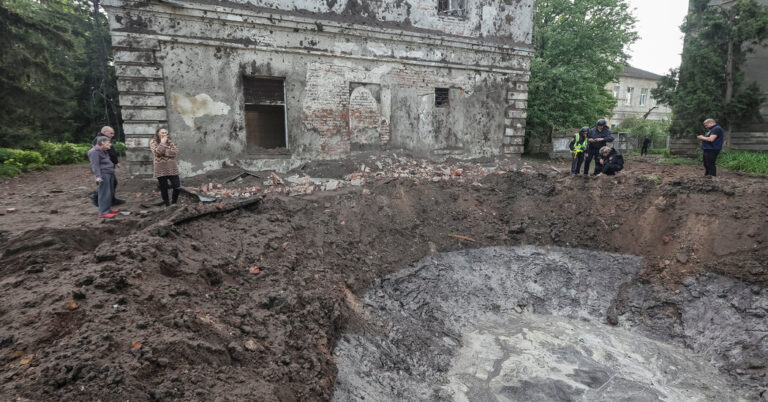As Russian missiles streaked through the skies above Ukraine before dawn on Saturday, once again targeting the nation’s already battered energy grid in a broad and complex bombardment, Ukrainian drones were flying in the other direction, taking aim at vital oil and gas refineries and other targets inside Russia.
The Ukrainian Air Force said its air defense teams had intercepted 21 of the 34 Russian cruise and ballistic missiles fired from land, air and sea-based systems, but the attack caused extensive damage to four thermal power plants and other critical parts of the power grid in three regions.
Russia’s Ministry of Defense said it had shot down 66 Ukrainian drones over the Krasnodar region, which is just across the Kerch Strait in southern Russia, east of the occupied Crimean Peninsula.
Veniamin Kondratyev, the head of the regional government, said the Ukrainian drones had targeted two oil refineries, a bitumen plant, and a military airfield in Kuban.
The Security Service of Ukraine, known as the S.B.U., said the Ukrainian military operation had targeted the Kushchevsk airfield and the Ilsky and Slavyansk oil refineries. The airfield housed “dozens of military aircraft, radars and electronic warfare devices,” the agency said in a statement, adding, “The S.B.U. continues to effectively target military and infrastructural facilities behind enemy lines, reducing Russia’s potential for waging war.”
The Kremlin tightly controls information about Ukrainian attacks, often making it difficult to assess their impact, and it was unclear how much damage the drone strikes caused.
Russia has also outlawed criticism of its war effort, aggressively stifling any voice deemed critical of the military and arresting hundreds of people as part of a widespread crackdown on dissent. On Friday, the Russian authorities arrested a journalist from the Russian edition of Forbes magazine, Sergei Mingazov, for reposting information on social media at the outset of the war about Russian atrocities, according to Russian officials and his lawyer, Konstantin Bubon.
Although the Russian authorities routinely deny or play down the impact of Ukrainian strikes inside Russia, the attacks on oil and gas facilities have been hard to hide. Britain’s military intelligence agency estimated last month that such strikes had disrupted at least 10 percent of Russia’s oil refinery capacity. On March 1, the Kremlin imposed a six-month ban on gasoline exports in what appeared to be an effort to avoid shortages and prevent spikes in domestic prices.
Ukraine has vowed to increase attacks inside Russia, using its expanding fleet of domestically produced long-range attack drones, even as the strikes on oil and gas infrastructure have stoked tensions between Kyiv and Washington. The Biden administration has publicly condemned the attacks, worried that they could lead to even greater Russian retaliation and drive up prices in global energy markets.
“Those attacks could have a knock-on effect in terms of the global energy situation,” the American defense secretary, Lloyd J. Austin III, told Congress this month. “Ukraine is better served in going after tactical and operational targets that can directly influence the current fight.”
The Biden administration’s stance is out of step with other allies, who have supported Kyiv’s use of its domestically produced weapons to go after what Ukraine considers legitimate military targets.
About a third of Russia’s national budget comes from oil and gas, and Ukrainian officials have said that attacks on the facilities strike at the heart of the Kremlin’s wartime economy. They also hope, over time, to undermine Russia’s ability to wage war, since refined oil products such as gasoline, diesel and jet fuel are essential for keeping any large army moving.
“Ukraine has the right to strike legitimate military targets outside the territory of their country to defend itself,” Jens Stoltenberg, the NATO secretary general, said this month when asked about strikes on Russian oil and gas facilities.
But the Russian strikes on Ukraine’s energy grid are also taking a growing toll as Moscow seeks to undermine Ukraine’s domestic arms industry, throttle its economy, deepen the suffering of millions of civilians and undermine the state’s ability to function.
Since resuming large-scale bombardments on power production facilities in late March, Russia has focused many of the attacks on thermal and hydro power plants, which are important in keeping the overall system in balance during peak periods of usage.
Before Saturday’s attack, Russia had already destroyed 80 percent of Ukraine’s thermal power generation capacity, energy officials said. The extent of the damage after the latest bombardment was still being determined on Saturday, energy officials said, but the cumulative impact is growing and threatens to cause lasting problems.
“The large-scale damage that Russia has caused recently cannot be repaired in a few weeks or even months,” Ukraine’s prime minister, Denys Shmyhal, said in a statement, urging people “to use electricity sparingly.”
Although American military assistance is flowing into Ukraine for the first time in months, Ukraine’s air defense systems remain stretched and short on ammunition. Ukraine is particularly vulnerable to Russian ballistic missiles, which can only be routinely countered by advanced American-made Patriot batteries.
“We urgently need Patriot systems and missiles for them,” President Volodymyr Zelensky said on Friday at a virtual meeting of the Ukraine Defense Contact Group, a consortium of about 50 nations that have provided military and humanitarian aid to Kyiv. “This is what can and should save lives right now.”
After Russia bombarded the Ukrainian energy grid in the winter of 2022-23, Kyiv’s allies supplied three Patriot batteries. But it has run low on the interceptor missiles they use. Germany has said it will supply a fourth Patriot battery soon, and Ukrainian officials are engaged in an urgent diplomatic drive to secure more of the systems and the munitions they require.
Ivan Nechepurenko contributed reporting.

